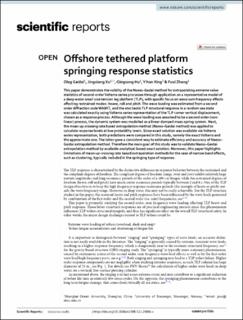| dc.contributor.author | Gaidai, Oleg | |
| dc.contributor.author | Xu, Jingxiang | |
| dc.contributor.author | Hu, Qingsong | |
| dc.contributor.author | Xing, Yihan | |
| dc.contributor.author | Zhang, Fuxi | |
| dc.date.accessioned | 2023-03-29T10:21:12Z | |
| dc.date.available | 2023-03-29T10:21:12Z | |
| dc.date.created | 2022-12-05T11:56:25Z | |
| dc.date.issued | 2022 | |
| dc.identifier.citation | Gaidai, O., Xu, J., Hu, Q., Xing, Y., & Zhang, F. (2022). Offshore tethered platform springing response statistics. Scientific Reports, 12(1), 21182. | en_US |
| dc.identifier.issn | 2045-2322 | |
| dc.identifier.uri | https://hdl.handle.net/11250/3060848 | |
| dc.description.abstract | This paper demonstrates the validity of the Naess–Gadai method for extrapolating extreme value statistics of second-order Volterra series processes through application on a representative model of a deep water small size tension leg platform (TLP), with specific focus on wave sum frequency effects affecting restrained modes: heave, roll and pitch. The wave loading was estimated from a second order diffraction code WAMIT, and the stochastic TLP structural response in a random sea state was calculated exactly using Volterra series representation of the TLP corner vertical displacement, chosen as a response process. Although the wave loading was assumed to be a second order (non-linear) process, the dynamic system was modelled as a linear damped mass-spring system. Next, the mean up-crossing rate based extrapolation method (Naess–Gaidai method) was applied to calculate response levels at low probability levels. Since exact solution was available via Volterra series representation, both predictions were compared in this study, namely the exact Volterra and the approximate one. The latter gave a consistent way to estimate efficiency and accuracy of Naess–Gaidai extrapolation method. Therefore the main goal of this study was to validate Naess–Gaidai extrapolation method by available analytical-based exact solution. Moreover, this paper highlights limitations of mean up-crossing rate based extrapolation methods for the case of narrow band effects, such as clustering, typically included in the springing type of response. | en_US |
| dc.language.iso | eng | en_US |
| dc.publisher | Nature | en_US |
| dc.rights | Navngivelse 4.0 Internasjonal | * |
| dc.rights.uri | http://creativecommons.org/licenses/by/4.0/deed.no | * |
| dc.title | Offshore tethered platform springing response statistics | en_US |
| dc.type | Peer reviewed | en_US |
| dc.type | Journal article | en_US |
| dc.description.version | publishedVersion | en_US |
| dc.rights.holder | The authors | en_US |
| dc.subject.nsi | VDP::Teknologi: 500 | en_US |
| dc.source.journal | Scientific Reports | en_US |
| dc.identifier.doi | 10.1038/s41598-022-25806-x | |
| dc.identifier.cristin | 2088650 | |
| cristin.ispublished | true | |
| cristin.fulltext | original | |
| cristin.qualitycode | 1 | |

